
A | B | C | D | E | F | G | H | CH | I | J | K | L | M | N | O | P | Q | R | S | T | U | V | W | X | Y | Z | 0 | 1 | 2 | 3 | 4 | 5 | 6 | 7 | 8 | 9
Cornwall
Kernow (Cornish) | |
|---|---|
 Cornwall shown within England | |
| Coordinates: 50°24′N 4°54′W / 50.400°N 4.900°W | |
| Sovereign state | United Kingdom |
| Constituent country | England |
| Region | South West England |
| Established | Ancient |
| Time zone | UTC+0 (GMT) |
| • Summer (DST) | UTC+1 (BST) |
| UK Parliament | 6 MPs |
| Police | Devon and Cornwall Police |
| Ceremonial county | |
| Lord Lieutenant | Edward Bolitho |
| High Sheriff | Stamford Timothy John Galsworthy (2024-25)[1] |
| Area | 3,562 km2 (1,375 sq mi) |
| • Rank | 12th of 48 |
| Population (2022)[2] | 577,694 |
| • Rank | 40th of 48 |
| Density | 162/km2 (420/sq mi) |
| Ethnicity | |
| Unitary authority | |
| Council | Cornwall Council |
| Control | Conservative |
| Admin HQ | Lys Kernow, Truro |
| Area | 3,545 km2 (1,369 sq mi) |
| • Rank | 4th of 296 |
| Population (2022)[4] | 575,413 |
| • Rank | 5th of 296 |
| Density | 162/km2 (420/sq mi) |
| ISO 3166-2 | GB-CON |
| GSS code | E06000052 |
| ITL | TLK30 |
| Website | cornwall |
| Districts | |
 Districts of Cornwall | |
| Districts |
|
Cornwall (/ˈkɔːrnwɔːl, -wəl/;[5] Cornish: Kernow; Cornish pronunciation: [ˈkɛrnɔʊ]; or [ˈkɛrnɔ][6]) is a ceremonial county in South West England.[7] It is recognised by Cornish and Celtic political groups as one of the Celtic nations, and is the homeland of the Cornish people. The county is bordered by the Atlantic Ocean to the north and west, Devon to the east, and the English Channel to the south. The largest settlement is Falmouth, and the county town is the city of Truro.
The county is rural, with an area of 1,375 square miles (3,562 km2) and population of 568,210. After Falmouth (23,061), the largest settlements are Penzance, Newquay, St Austell, and Truro. For local government purposes most of Cornwall is a unitary authority area, with the Isles of Scilly having a unique local authority. The Cornish nationalist movement disputes the constitutional status of Cornwall and seeks greater autonomy within the United Kingdom.
Cornwall is the westernmost part of the South West Peninsula. Its coastline is characterised by steep cliffs and, to the south, several rias, including those at the mouths of the rivers Fal and Fowey. It includes the southernmost point on Great Britain, Lizard Point, and forms a large part of the Cornwall National Landscape. The national landscape also includes Bodmin Moor, an upland outcrop of the Cornubian batholith granite formation. The county contains many short rivers; the longest is the Tamar, which forms the border with Devon.
Cornwall had a minor Roman presence, and later formed part of the Brittonic kingdom of Dumnonia. From the 7th century, the Britons in the South West increasingly came into conflict with the expanding Anglo-Saxon kingdom of Wessex, eventually being pushed west of the Tamar; by the Norman Conquest Cornwall was administered as part of England, though it retained its own culture. The remainder of the Middle Ages and Early Modern Period were relatively settled, with Cornwall developing its tin mining industry and becoming a duchy in 1337. During the Industrial Revolution, the tin and copper mines were expanded and then declined, with china clay extraction becoming a major industry. Railways were built, leading to a growth of tourism in the 20th century. The Cornish language became extinct as a living community language at the end of the 18th century, but is now being revived.
Name
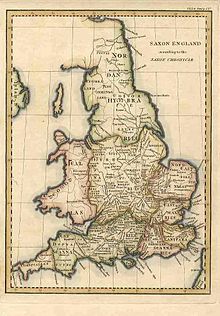

The modern English name "Cornwall" is a compound of two terms coming from two different language groups:
- "Corn-" originates from the Proto-Celtic *karnu- ("horn", presumed in reference to "headland"), and is cognate with the English word "horn" and Latin "cornu" (both deriving from the Proto-Indo-European *ker-). There may also have been an Iron Age group that occupied the Cornish peninsula known as the Cornovii (i.e. "people of the horn or headland").[8][9][10][11][a]
- "-wall" derives from wealh, an exonym in Old English meaning "foreigner", "slave" or "Brittonic-speaker" (as in Welsh).[13]
In the Cornish language, Cornwall is Kernow which stems from the same Proto-Celtic root.
History

Prehistory, Roman and post-Roman periods
Humans reoccupied Britain after the last Ice Age. The area now known as Cornwall was first inhabited in the Palaeolithic and Mesolithic periods. It continued to be occupied by Neolithic and then by Bronze Age people.
Cornwall in the Late Bronze Age formed part of a maritime trading-networked culture which researchers have dubbed the Atlantic Bronze Age system, and which extended over most of the areas of present-day Ireland, England, Wales, France, Spain, and Portugal.[14][15]
During the British Iron Age, Cornwall, like all of Britain (modern England, Scotland, Wales, and the Isle of Man), was inhabited by a Celtic-speaking people known as the Britons with distinctive cultural relations to neighbouring Brittany. The Common Brittonic spoken at this time eventually developed into several distinct tongues, including Cornish, Welsh, Breton, Cumbric and Pictish.[16]
The first written account of Cornwall comes from the 1st-century BC Sicilian Greek historian Diodorus Siculus, supposedly quoting or paraphrasing the 4th-century BCE geographer Pytheas, who had sailed to Britain:
The inhabitants of that part of Britain called Belerion (or Land's End) from their intercourse with foreign merchants, are civilized in their manner of life. They prepare the tin, working very carefully the earth in which it is produced ... Here then the merchants buy the tin from the natives and carry it over to Gaul, and after traveling overland for about thirty days, they finally bring their loads on horses to the mouth of the Rhône.[17]
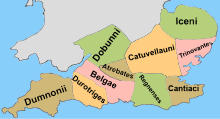
The identity of these merchants is unknown. It has been theorized that they were Phoenicians, but there is no evidence for this.[18] Professor Timothy Champion, discussing Diodorus Siculus's comments on the tin trade, states that "Diodorus never actually says that the Phoenicians sailed to Cornwall. In fact, he says quite the opposite: the production of Cornish tin was in the hands of the natives of Cornwall, and its transport to the Mediterranean was organized by local merchants, by sea and then overland through France, passing through areas well outside Phoenician control."[19] Isotopic evidence suggests that tin ingots found off the coast of Haifa, Israel, may have been from Cornwall.[20][21] Tin, required for the production of bronze, was a relatively rare and precious commodity in the Bronze Age – hence the interest shown in Devon and Cornwall's tin resources. (For further discussion of tin mining see the section on the economy below.)
In the first four centuries AD, during the time of Roman dominance in Britain, Cornwall was rather remote from the main centres of Romanization – the nearest being Isca Dumnoniorum, modern-day Exeter. However, the Roman road system extended into Cornwall with four significant Roman sites based on forts:[22] Tregear near Nanstallon was discovered in the early 1970s, two others were found at Restormel Castle, Lostwithiel in 2007, and a third fort near Calstock was also discovered early in 2007. In addition, a Roman-style villa was found at Magor Farm, Illogan in 1935. Ptolemy's Geographike Hyphegesis mentions four towns controlled by the Dumnonii,[23] three of which may have been in Cornwall.[24] However, after 410 AD, Cornwall appears to have reverted to rule by Romano-Celtic chieftains of the Cornovii tribe as part of the Brittonic kingdom of Dumnonia (which also included present-day Devonshire and the Scilly Isles), including the territory of one Marcus Cunomorus, with at least one significant power base at Tintagel in the early 6th century.
"King" Mark of Cornwall is a semi-historical figure known from Welsh literature, from the Matter of Britain, and, in particular, from the later Norman-Breton medieval romance of Tristan and Yseult, where he appears as a close relative of King Arthur, himself usually considered to be born of the Cornish people in folklore traditions derived from Geoffrey of Monmouth's 12th-century Historia Regum Britanniae.
Archaeology supports ecclesiastical, literary and legendary evidence for some relative economic stability and close cultural ties between the sub-Roman Westcountry, South Wales, Brittany, the Channel Islands, and Ireland through the fifth and sixth centuries.[25] In Cornwall, the arrival of Celtic saints such as Nectan, Paul Aurelian, Petroc, Piran, Samson and numerous others reinforced the preexisting Roman Christianity.[26]
Conflict with Wessex
The Battle of Deorham in 577 saw the separation of Dumnonia (and therefore Cornwall) from Wales, following which the Dumnonii often came into conflict with the expanding English kingdom of Wessex. Centwine of Wessex "drove the Britons as far as the sea" in 682, and by 690 St Bonifice, then a Saxon boy, was attending an abbey in Exeter, which was in turn ruled by a Saxon abbot.[26][27] The Carmen Rhythmicum written by Aldhelm contains the earliest literary reference to Cornwall as distinct from Devon. Religious tensions between the Dumnonians (who celebrated celtic Christian traditions) and Wessex (who were Roman Catholic) are described in Aldhelm's letter to King Geraint. The Annales Cambriae report that in AD 722 the Britons of Cornwall won a battle at "Hehil".[28] It seems likely that the enemy the Cornish fought was a West Saxon force, as evidenced by the naming of King Ine of Wessex and his kinsman Nonna in reference to an earlier Battle of Llongborth in 710.[29]
The Anglo-Saxon Chronicle stated in 815 (adjusted date) "and in this year king Ecgbryht raided in Cornwall from east to west." this has been interpreted to mean a raid from the Tamar to Land's End, and the end of Cornish independence.[30] However, the Anglo-Saxon Chronicle states that in 825 (adjusted date) a battle took place between the Wealas (Cornish) and the Defnas (men of Devon) at Gafulforda. The Cornish giving battle here, and the later battle at Hingston Down, casts doubt on any claims of control Wessex had at this stage.[31]
In 838, the Cornish and their Danish allies were defeated by Egbert in the Battle of Hingston Down at Hengestesdune. In 875, the last recorded king of Cornwall, Dumgarth, is said to have drowned.[32] Around the 880s, Anglo-Saxons from Wessex had established modest land holdings in the north eastern part of Cornwall; notably Alfred the Great who had acquired a few estates.[33] William of Malmesbury, writing around 1120, says that King Athelstan of England (924–939) fixed the boundary between English and Cornish people at the east bank of the River Tamar.[34] While elements of William's story, like the burning of Exeter, have been cast in doubt by recent writers[31] Athelstan did re-establish a separate Cornish Bishop and relations between Wessex and the Cornish elite improved from the time of his rule.
Eventually King Edgar was able to issue charters the width of Cornwall, and frequently sent emissaries or visited personally as seen by his appearances in the Bodmin Manumissions.
Breton–Norman period

One interpretation of the Domesday Book is that by this time the native Cornish landowning class had been almost completely dispossessed and replaced by English landowners, particularly Harold Godwinson himself. However, the Bodmin manumissions show that two leading Cornish figures nominally had Saxon names, but these were both glossed with native Cornish names.[35] In 1068, Brian of Brittany may have been created Earl of Cornwall, and naming evidence cited by medievalist Edith Ditmas suggests that many other post-Conquest landowners in Cornwall were Breton allies of the Normans, the Bretons being descended from Britons who had fled to what is today Brittany during the early years of the Anglo-Saxon conquest.[36] She also proposed this period for the early composition of the Tristan and Iseult cycle by poets such as Béroul from a pre-existing shared Brittonic oral tradition.[37]
Soon after the Norman conquest most of the land was transferred to the new Breton–Norman aristocracy, with the lion's share going to Robert, Count of Mortain, half-brother of King William and the largest landholder in England after the king with his stronghold at Trematon Castle near the mouth of the Tamar.[38]
Later medieval administration and society
Subsequently, however, Norman absentee landlords became replaced by a new Cornish-Norman ruling class including scholars such as Richard Rufus of Cornwall. These families eventually became the new rulers of Cornwall, typically speaking Norman French, Breton-Cornish, Latin, and eventually English, with many becoming involved in the operation of the Stannary Parliament system, the Earldom and eventually the Duchy of Cornwall.[39] The Cornish language continued to be spoken and acquired a number of characteristics establishing its identity as a separate language from Breton.
Stannary parliaments
The stannary parliaments and stannary courts were legislative and legal institutions in Cornwall and in Devon (in the Dartmoor area). The stannary courts administered equity for the region's tin-miners and tin mining interests, and they were also courts of record for the towns dependent on the mines. The separate and powerful government institutions available to the tin miners reflected the enormous importance of the tin industry to the English economy during the Middle Ages. Special laws for tin miners pre-date written legal codes in Britain, and ancient traditions exempted everyone connected with tin mining in Cornwall and Devon from any jurisdiction other than the stannary courts in all but the most exceptional circumstances.
Piracy and smuggling
Cornish piracy was active during the Elizabethan era on the west coast of Britain.[40] Cornwall is well known for its wreckers who preyed on ships passing Cornwall's rocky coastline. During the 17th and 18th centuries Cornwall was a major smuggling area.
Heraldry
In later times, Cornwall was known to the Anglo-Saxons as "West Wales" to distinguish it from "North Wales" (the modern nation of Wales).[41] The name appears in the Anglo-Saxon Chronicle in 891 as On Corn walum. In the Domesday Book it was referred to as Cornualia and in c. 1198 as Cornwal.[42][b] Other names for the county include a latinisation of the name as Cornubia (first appears in a mid-9th-century deed purporting to be a copy of one dating from c. 705), and as Cornugallia in 1086.
Physical geography

Cornwall forms the tip of the south-west peninsula of the island of Great Britain, and is therefore exposed to the full force of the prevailing winds that blow in from the Atlantic Ocean. The coastline is composed mainly of resistant rocks that give rise in many places to tall cliffs. Cornwall has a border with only one other county, Devon, which is formed almost entirely by the River Tamar, and the remainder (to the north) by the Marsland Valley.
Coastal areas
The north and south coasts have different characteristics. The north coast on the Celtic Sea, part of the Atlantic Ocean, is more exposed and therefore has a wilder nature. The High Cliff, between Boscastle and St Gennys, is the highest sheer-drop cliff in Cornwall at 223 metres (732 ft).[44] Beaches, which form an important part of the tourist industry, include Bude, Polzeath, Watergate Bay, Perranporth, Porthtowan, Fistral Beach, Newquay, St Agnes, St Ives, and on the south coast Gyllyngvase beach in Falmouth and the large beach at Praa Sands further to the south-west. There are two river estuaries on the north coast: Hayle Estuary and the estuary of the River Camel, which provides Padstow and Rock with a safe harbour. The seaside town of Newlyn is a popular holiday destination, as it is one of the last remaining traditional Cornish fishing ports, with views reaching over Mount's Bay.

The south coast, dubbed the "Cornish Riviera", is more sheltered and there are several broad estuaries offering safe anchorages, such as at Falmouth and Fowey. Beaches on the south coast usually consist of coarser sand and shingle, interspersed with rocky sections of wave-cut platform. Also on the south coast, the picturesque fishing village of Polperro, at the mouth of the Pol River, and the fishing port of Looe on the River Looe are both popular with tourists.
Inland areas
The interior of the county consists of a roughly east–west spine of infertile and exposed upland, with a series of granite intrusions, such as Bodmin Moor, which contains the highest land within Cornwall. From east to west, and with approximately descending altitude, these are Bodmin Moor, Hensbarrow north of St Austell, Carnmenellis to the south of Camborne, and the Penwith or Land's End peninsula. These intrusions are the central part of the granite outcrops that form the exposed parts of the Cornubian batholith of south-west Britain, which also includes Dartmoor to the east in Devon and the Isles of Scilly to the west, the latter now being partially submerged.

The intrusion of the granite into the surrounding sedimentary rocks gave rise to extensive metamorphism and mineralisation, and this led to Cornwall being one of the most important mining areas in Europe until the early 20th century. It is thought tin was mined here as early as the Bronze Age, and copper, lead, zinc and silver have all been mined in Cornwall. Alteration of the granite also gave rise to extensive deposits of China Clay, especially in the area to the north of St Austell, and the extraction of this remains an important industry.
The uplands are surrounded by more fertile, mainly pastoral farmland. Near the south coast, deep wooded valleys provide sheltered conditions for flora that like shade and a moist, mild climate. These areas lie mainly on Devonian sandstone and slate. The north east of Cornwall lies on Carboniferous rocks known as the Culm Measures. In places these have been subjected to severe folding, as can be seen on the north coast near Crackington Haven and in several other locations.
Lizard Peninsula
The geology of the Lizard peninsula is unusual, in that it is mainland Britain's only example of an ophiolite, a section of oceanic crust now found on land.[c] Much of the peninsula consists of the dark green and red Precambrian serpentinite, which forms spectacular cliffs, notably at Kynance Cove, and carved and polished serpentine ornaments are sold in local gift shops. This ultramafic rock also forms a very infertile soil which covers the flat and marshy heaths of the interior of the peninsula. This is home to rare plants, such as the Cornish Heath, which has been adopted as the county flower.[45]
Hills and high points
Settlements and transport
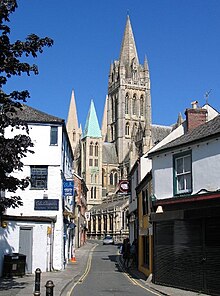
Cornwall's only city, and the home of the council headquarters, is Truro. Nearby Falmouth is notable as a port. St Just in Penwith is the westernmost town in England, though the same claim has been made for Penzance, which is larger. St Ives and Padstow are today small vessel ports with a major tourism and leisure sector in their economies. Newquay on the north coast is another major urban settlement which is known for its beaches and is a popular surfing destination, as is Bude further north, but Newquay is now also becoming important for its aviation-related industries. Camborne is the county's largest town and more populous than the county town Truro. Together with the neighbouring town of Redruth, it forms the largest urban area in Cornwall, and both towns were significant as centres of the global tin mining industry in the 19th century; nearby copper mines were also very productive during that period. St Austell is also larger than Truro and was the centre of the china clay industry in Cornwall. Until four new parishes were created for the St Austell area on 1 April 2009 St Austell was the largest settlement in Cornwall.[46]
Cornwall borders the county of Devon at the River Tamar. Major roads between Cornwall and the rest of Great Britain are the A38 which crosses the Tamar at Plymouth via the Tamar Bridge and the town of Saltash, the A39 road (Atlantic Highway) from Barnstaple, passing through North Cornwall to end in Falmouth, and the A30 which connects Cornwall to the M5 motorway at Exeter, crosses the border south of Launceston, crosses Bodmin Moor and connects Bodmin, Truro, Redruth, Camborne, Hayle and Penzance. Torpoint Ferry links Plymouth with Torpoint on the opposite side of the Hamoaze. A rail bridge, the Royal Albert Bridge built by Isambard Kingdom Brunel (1859), provides the other main land transport link. The city of Plymouth, a large urban centre in south west Devon, is an important location for services such as hospitals, department stores, road and rail transport, and cultural venues, particularly for people living in east Cornwall.
Cardiff and Swansea, across the Bristol Channel, have at some times in the past been connected to Cornwall by ferry, but these do not operate now.[47]
The Isles of Scilly are served by ferry (from Penzance) and by aeroplane, having its own airport: St Mary's Airport. There are regular flights between St Mary's and Land's End Airport, near St Just, and Newquay Airport; during the summer season, a service is also provided between St Mary's and Exeter Airport, in Devon.
Ecology
Flora and fauna
Cornwall has varied habitats including terrestrial and marine ecosystems. One noted species in decline locally is the Reindeer lichen, which species has been made a priority for protection under the national UK Biodiversity Action Plan.[48][49]
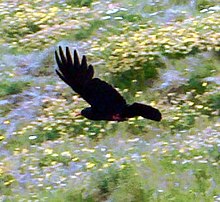
Botanists divide Cornwall and Scilly into two vice-counties: West (1) and East (2). The standard flora is by F. H. Davey Flora of Cornwall (1909). Davey was assisted by A. O. Hume and he thanks Hume, his companion on excursions in Cornwall and Devon, and for help in the compilation of that Flora, publication of which was financed by him.
Climate
Cornwall has a temperate Oceanic climate (Köppen climate classification: Cfb), with mild winters and cool summers. Cornwall has the mildest and one of the sunniest climates of the United Kingdom, as a result of its oceanic setting and the influence of the Gulf Stream.[50] The average annual temperature in Cornwall ranges from 11.6 °C (52.9 °F) on the Isles of Scilly to 9.8 °C (49.6 °F) in the central uplands. Winters are among the warmest in the country due to the moderating effects of the warm ocean currents, and frost and snow are very rare at the coast and are also rare in the central upland areas. Summers are, however, not as warm as in other parts of southern England.[51] The surrounding sea and its southwesterly position mean that Cornwall's weather can be relatively changeable.
Cornwall is one of the sunniest areas in the UK. It has more than 1,541 hours of sunshine per year, with the highest average of 7.6 hours of sunshine per day in July.[52] The moist, mild air coming from the southwest brings higher amounts of rainfall than in eastern Great Britain, at 1,051 to 1,290 mm (41.4 to 50.8 in) per year. However, this is not as much as in more northern areas of the west coast.[53] The Isles of Scilly, for example, where there are on average fewer than two days of air frost per year, is the only area in the UK to be in the Hardiness zone 10. The islands have, on average, less than one day of air temperature exceeding 30 °C per year and are in the AHS Heat Zone 1. Extreme temperatures in Cornwall are particularly rare; however, extreme weather in the form of storms and floods is common. Due to climate change Cornwall faces more heatwaves and severe droughts, faster coastal erosion, stronger storms and higher wind speeds as well as the possibility of more high impact flooding.[54]
Culture
Language
Cornish language

Cornish, a member of the Brythonic branch of the Celtic language family, died out as a first language in the late 18th century. In the 20th and 21st centuries, it has been revived by a small number of speakers. It is closely related to the other Brythonic languages (Breton and Welsh), and less so to the Goidelic languages. Cornish has no legal status in the UK.
There has been a revival of the language by academics and optimistic enthusiasts since the mid-19th century that gained momentum from the publication in 1904 of Henry Jenner's Handbook of the Cornish Language. It is a social networking community language rather than a social community group language.[55] Cornwall Council encourages and facilitates language classes within the county, in schools and within the wider community.[56]
In 2002, Cornish was named as a UK regional language in the European Charter for Regional or Minority Languages.[57] As a result, in 2005 its promoters received limited government funding.[58] Several words originating in Cornish are used in the mining terminology of English, such as costean, gossan,[59] gunnies, kibbal,[60] kieve[61] and vug.[62]
English dialect
The Cornish language and culture influenced the emergence of particular pronunciations and grammar not used elsewhere in England. The Cornish dialect is spoken to varying degrees; however, someone speaking in broad Cornish may be practically unintelligible to one not accustomed to it. Cornish dialect has generally declined, as in most places it is now little more than a regional accent and grammatical differences have been eroded over time. Marked differences in vocabulary and usage still exist between the eastern and western parts of Cornwall.
Flag

Saint Piran's Flag is the national flag and ancient banner of Cornwall,[63][64][65] and an emblem of the Cornish people. The banner of Saint Piran is a white cross on a black background (in terms of heraldry 'sable, a cross argent'). According to legend Saint Piran adopted these colours from seeing the white tin in the black coals and ashes during his discovery of tin.[63][66] The Cornish flag is an exact reverse of the former Breton black cross national flag and is known by the same name "Kroaz Du".[67][68]

Arts and media
edit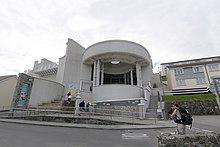
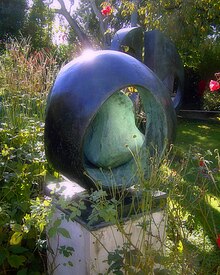
Since the 19th century, Cornwall, with its unspoilt maritime scenery and strong light, has sustained a vibrant visual art scene of international renown. Artistic activity within Cornwall was initially centred on the art-colony of Newlyn, most active at the turn of the 20th century. This Newlyn School is associated with the names of Stanhope Forbes, Elizabeth Forbes,[69] Norman Garstin and Lamorna Birch.[70] Modernist writers such as D. H. Lawrence and Virginia Woolf lived in Cornwall between the wars,[71] and Ben Nicholson, the painter, having visited in the 1920s came to live in St Ives with his then wife, the sculptor Barbara Hepworth, at the outbreak of the Second World War.[72] They were later joined by the Russian emigrant Naum Gabo,[73] and other artists. These included Peter Lanyon, Terry Frost, Patrick Heron, Bryan Wynter and Roger Hilton. St Ives also houses the Leach Pottery, where Bernard Leach, and his followers championed Japanese inspired studio pottery.[74] Much of this modernist work can be seen in Tate St Ives.[75] The Newlyn Society and Penwith Society of Arts continue to be active, and contemporary visual art is documented in a dedicated online journal.[76]
Local television programmes are provided by BBC South West[77] & ITV West Country.[78] Radio programmes are produced by BBC Radio Cornwall in Truro for the entire county, Heart West, Source FM for the Falmouth and Penryn areas, Coast FM for west Cornwall, Radio St Austell Bay for the St Austell area, NCB Radio for north Cornwall & Pirate FM.[79]
Music
editCornwall has a folk music tradition that has survived into the present and is well known for its unusual folk survivals such as Mummers Plays, the Furry Dance in Helston played by the famous Helston Town Band, and Obby Oss in Padstow.
Newlyn is home to a food and music festival[80] that hosts live music, cooking demonstrations, and displays of locally caught fish.
As in other former mining districts of Britain, male voice choirs and brass bands, such as Brass on the Grass concerts during the summer at Constantine, are still very popular in Cornwall. Cornwall also has around 40 brass bands, including the six-times National Champions of Great Britain, Camborne Youth Band, and the bands of Lanner and St Dennis.
Cornish players are regular participants in inter-Celtic festivals, and Cornwall itself has several inter-Celtic festivals such as Perranporth's Lowender Peran folk festival.[81]
Contemporary musician Richard D. James (also known as Aphex Twin) grew up in Cornwall, as did Luke Vibert and Alex Parks, winner of Fame Academy 2003. Roger Taylor, the drummer from the band Queen was also raised in the county, and currently lives not far from Falmouth. The American singer-songwriter Tori Amos now resides predominantly in North Cornwall not far from Bude with her family.[82] The lutenist, composer and festival director Ben Salfield lives in Truro. Mick Fleetwood of Fleetwood Mac was born in Redruth.
Literature
editCornwall's rich heritage and dramatic landscape have inspired numerous writers.
Fiction
editSir Arthur Quiller-Couch, author of many novels and works of literary criticism, lived in Fowey: his novels are mainly set in Cornwall. Daphne du Maurier lived at Menabilly near Fowey and many of her novels had Cornish settings: The Loving Spirit, Jamaica Inn, Rebecca, Frenchman's Creek, The King's General (partially), My Cousin Rachel, The House on the Strand and Rule Britannia.[83] She is also noted for writing Vanishing Cornwall. Cornwall provided the inspiration for The Birds, one of her terrifying series of short stories, made famous as a film by Alfred Hitchcock.[84]
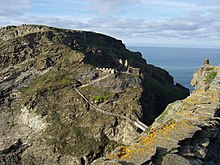
Text je dostupný za podmienok Creative Commons Attribution/Share-Alike License 3.0 Unported; prípadne za ďalších podmienok. Podrobnejšie informácie nájdete na stránke Podmienky použitia.
Antropológia
Aplikované vedy
Bibliometria
Dejiny vedy
Encyklopédie
Filozofia vedy
Forenzné vedy
Humanitné vedy
Knižničná veda
Kryogenika
Kryptológia
Kulturológia
Literárna veda
Medzidisciplinárne oblasti
Metódy kvantitatívnej analýzy
Metavedy
Metodika
Text je dostupný za podmienok Creative
Commons Attribution/Share-Alike License 3.0 Unported; prípadne za ďalších
podmienok.
Podrobnejšie informácie nájdete na stránke Podmienky
použitia.
www.astronomia.sk | www.biologia.sk | www.botanika.sk | www.dejiny.sk | www.economy.sk | www.elektrotechnika.sk | www.estetika.sk | www.farmakologia.sk | www.filozofia.sk | Fyzika | www.futurologia.sk | www.genetika.sk | www.chemia.sk | www.lingvistika.sk | www.politologia.sk | www.psychologia.sk | www.sexuologia.sk | www.sociologia.sk | www.veda.sk I www.zoologia.sk




